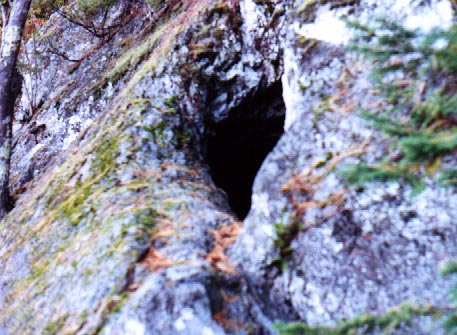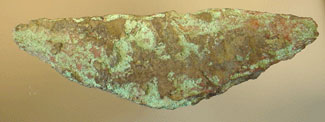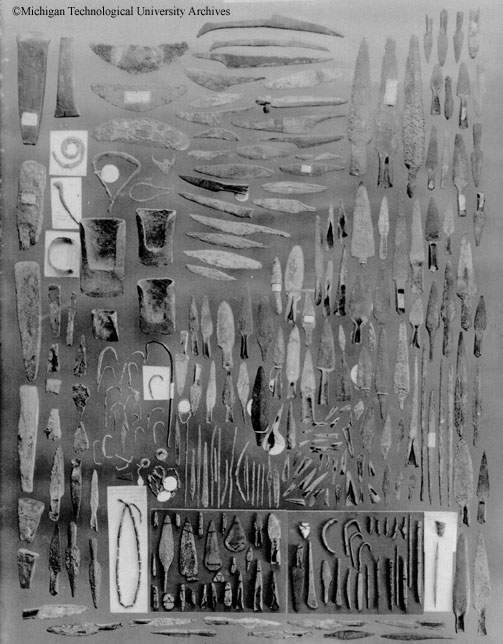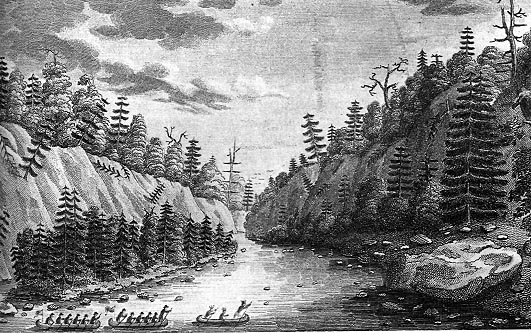| Home | AmMin | GMR | RiMG | Collectors Corner | Directory | Short Courses | |
|
|
|||||||

|
VIRTUAL FIELD TRIP TO THE KEWEENAW PENINSULA, MICHIGAN - MINING HISTORY (PRE 1840)
|
The Native Americans used the copper from this area for the last 6800 years. The natives mined the copper from the bedrock as well as from glacial deposits. The entire peninsula from Keweenaw Point to the Ontonagon River area contain ancient mining pits. The deposits on Isle Royale were also mined by natives ( a conservative estimate is that there were at least 1089 pits on the island). The native mines range from open surface pits to shafts up to 18 feet deep. Currently, most pits have been filled in with debris from surrounding area, leaf litter and trees growing in them. Many were also destroyed by later mining efforts. The natives were primarily interested in native copper from the small fissure veins. This would give them material that was simple to work on ( neither too small, which would have required melting to consolidate into workable pieces or so large that splitting the pieces into workable sizes was impossible with the available tools).
Ancient Native American mining pit located above the Nebraska mine ( 2 feet across). Most of these pits on more level ground have been filled with debris in the years since they were active. Native miners used hammer stones of diorite and other local rocks that they recovered from the beaches in the area. They modified the naturally rounded and smoothed cobbles somewhat to allow hafting ( attaching handles or flexible vines) of the hammers or just used suitable naturally shaped rocks. The rock adjacent to pieces of native copper was hammered by the stones until the country rock was pulverized or broken into pieces. When the hammer stones were broken, they were thrown away in the area. The natives used various sizes of hammer stones, with the larger ones to do the initial rock breaking, smaller rocks to work the ore out, and small handheld rocks for delicate mining or forming of the copper. Wooden planks were often used to remove the mining debris from the pits. There is no definitive evidence that the natives used fire in the mining operations to fracture the rocks enclosing the copper. There has been charcoal found in the pits, but whether this has resulted from mining operations or just forest fires in the area, has been difficult to determine. Most of the mined surfaces seem to have been pecked with stone tools. The question is whether heating the rock to create fractures would have resulted in less labor than just pulverizing the country rock. Obtaining fuel to light the fires would probably not have been much easier than the actual mining of the ore.
This is a hammer stone found at the Nebraska mine. It is about 12.5cm in length. One can see the groove around the middle where it would have been hafted into a handle. The hammer is broken on the reverse side and was discarded near the mine. On the left hand side of the hammer is a vein of coarser grained rock running through the hammer ( almost a fine grained pegmatite). The natives used the copper to create projectile points ( spear points, arrowheads, harpoons), cutting tools, chisels, knives, celts, axes, wedges, awls, fishhooks, gaffs and ornaments ( beads, bracelets, gorgets [small breast plates]). They would hammer the copper into sheets and then form the tools. The hammering would work harden the copper so a heating in the fire allowed the metal to anneal and remove the dislocations that cause brittleness. They would grind the cutting edges to sharpen them. There is no evidence that they melted the copper and poured it into molds. The copper was already a pure native metal so that they did not have to heat ore up and smelt it from copper compounds.
This is a wedge of native copper. It is approximately 22 cm long. Since it was buried, there has been some oxidation of the copper to cuprite and some minor malachite.
This is a "crescent" of copper (11.5 cm wide). What the actual use for what these were put to is conjectural.
Native copper from this area was evidently traded to other areas in the Midwest and beyond. It is difficult to correlate the copper artifacts with the area in which they were mined. Some of the eastern archeological sites could have used copper from Nova Scotia or the Appalachian Mountains. The copper was probably traded both as finished artifacts and as raw material. Some lithic (rock) artifacts were probably traded for the copper, since good stone for making tools was not present on the Keweenaw.
The French explorer, Cartier explored the St Lawrence River in Canada in the 1530's and 1540's and received tools made from Lake Superior copper. The expedition's experiment of mining for gold and diamonds in Canada unfortunately only produced "fools" gold (pyrite) and quartz crystals when the "ore" arrived in France. There were numerous attempts by the voyageurs and missionaries to locate mineral wealth in the area in the late 1600's. Between 1720 and 1740 a major effort was made by De la Ronde to open up copper mining in the area. In 1771 a party of miners was sent out by the Englishman Henry and eventually began mining near the Ontonagon boulder. They drove an adit into the hillside, but this collapsed during the spring thaw and put a damper on the mining effort. Although there were various attempts to explore the region starting in 1800, the first official exploration was undertaken by the Lewis Cass, the first territorial governor of Michigan in 1820. His chief scientist on the expedition was Henry Schoolcraft Ontonagon boulder as depicted in Schoolcraft's "Narrative Journal of Travels in 1821" from the Cass expedition. Note the relative size of the boulder on the right river bank versus the men in the canoes. The Ontonagon boulder is actually just three feet eight inches in the largest dimension and weighed 3708 pounds. It was initially exhibited in Detroit in 1843 and was eventually acquired by the Smithsonian Institution. For present day view of original location of boulder click above picture.
|






